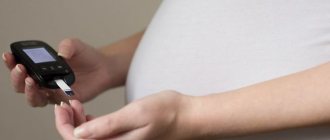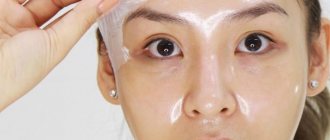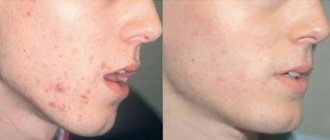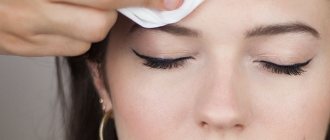Urticaria is a group of diseases (mainly of an allergic nature), the characteristic symptom of which is a rash on the skin in the form of red blisters.
In Russia, urticaria is very common - from 10 to 20% of the population have experienced its manifestations at least once in their lives. Moreover, in the majority it occurs in an acute form (70-75%), in the rest it takes a chronic course. WHO (World Health Organization) predicts that the 21st century will be the century of allergies. Every year the number of patients with one form of allergy or another increases by 5%.
Symptoms and mechanisms of development of urticaria
The appearance of the main symptoms of urticaria - blisters and redness - is associated with the mechanism of development of the disease. This is an increase in vascular permeability and acute swelling in the tissues that surround the vessels.
The mast cell plays a leading role in the development of urticaria. These are special immune cells, the granules of which contain special biologically active substances (mediators). The most studied of them is histamine. It is because of its action that the symptoms of urticaria arise - rashes, redness, swelling, itching.
A blistering rash appears suddenly on any part of the body, disappears quickly and without a trace within 24 hours, and then appears elsewhere. When you press on the center of the redness, a white spot is visible.
The itching begins at the same time as the rash. This is how histamine acts on nerve endings.
Depending on the factor that activated the release of histamine from mast cell granules, different types of urticaria are distinguished.
In children with urticaria, there may be a deterioration in their general condition: increased body temperature, disruption of the digestive system (diarrhea).
What your facial skin tells you during pregnancy
Often, you can guess that a woman is expecting a baby even before the characteristic roundness appears in the abdominal area. Just look at it: very often the skin of the face changes noticeably in the early stages of pregnancy. This is due to hormonal changes occurring in the body. Such changes do not always please the expectant mother, but it is important to understand that they are completely natural.
FACE COLOR AND PIGMENTATION
The first thing you can notice is changes in facial skin tone during pregnancy. Often the expectant mother’s cheeks are too brightly colored. This indicates an increased load on the blood vessels, which is quite natural during pregnancy. If a woman already had freckles, they may become even more noticeable. Brown-haired and brunette women often encounter chloasma, popularly known as the mask of pregnant women. In this case, individual areas on the forehead, cheeks, chin, as well as on the back of the nose and under the lip darken. Because of this, the skin of the face acquires an uneven shade. Skin pigmentation in expectant mothers is completely natural: this is a consequence of increased levels of progesterone in the body. But don’t think that such changes will remain forever. Even if the skin of the face deteriorates during pregnancy, as a rule, after the birth of the baby, it gradually returns to its previous shade. So it is not necessary to resort to complex procedures to combat pigmentation, just be patient.
SWELLING
Many women expecting a baby experience swelling. They are especially noticeable on the face. Due to swelling, it becomes larger and rounder. Such changes can be expressed to varying degrees. How to determine whether swelling has appeared? To do this, gently press on the skin with your finger. If a hole has formed on it, most likely, we are talking about the presence of edema. In this case, it is important to consult with your pregnancy doctor in a timely manner. The specialist will adjust the diet and also prescribe treatment, if necessary.
EXCESSIVE HAIR
At the end of the first trimester of pregnancy, many women notice that the amount of hair on their body has increased. Noticeable hairs may also appear on the face. This is due to the increase in the level of androgens, sex hormones, that occurs during this period. To remove facial hair, you can use tweezers, sugar or wax hair removal. However, during pregnancy it is not recommended to use chemicals to combat unwanted vegetation. In fact, it is not at all necessary to remove hairs that have grown on your face and body: they will disappear on their own about six months after giving birth.
RASHES
Many women complain that their perfectly clean skin has deteriorated during pregnancy: pimples have appeared on it. Rashes can be associated with both an allergic reaction and hormonal disorders. When it comes to allergies, a small, clearly visible rash usually appears on the skin, which may be accompanied by itching. With hormonal changes associated with an increase in progesterone levels, the work of the sebaceous glands is activated. As a result, acne may appear on a pregnant woman's face. The occurrence of such problems is facilitated by an unbalanced diet, genetic factors, and lack of fresh air. If acne appears, you should consult a dermatologist, making sure to inform the specialist about your ongoing pregnancy. The doctor will select therapy taking into account the woman’s condition: not all components of medicinal creams, lotions and other products are approved for use during this period.
DOES THE CONDITION OF THE SKIN ALWAYS CHANGE FOR THE WORSE?
You should not think that carrying a baby will certainly lead to a deterioration in the appearance of the expectant mother. It often happens that the skin of the face during pregnancy glows with health and beauty! Hormonal changes can improve cell function and have a rejuvenating effect on the body. In addition, the expectant mother has the power to properly care for her skin to help maintain its elasticity, softness and healthy tone.
HOW TO PROPERLY CARE FOR YOUR SKIN DURING PREGNANCY
Use suitable cosmetics. During this period, it is especially important to study the composition of cosmetics. To cleanse the skin, it is recommended to use mild products without aggressive components. If rashes appear, the best option is doctor-recommended products with antiseptic ingredients. You can use cosmetics designed specifically for pregnant women.
Protect your skin from the sun. At any time of the year, it is important to apply cream with SPF factor before going outside. Exposure to ultraviolet light can increase pigmentation, which appears under the influence of hormonal changes.
Choose gentle procedures. Deep peelings and traumatic mechanical facial cleansing are not suitable for pregnant women, because during this period the skin becomes especially sensitive and the pain threshold decreases.
Watch your diet. It is recommended to include foods rich in polyunsaturated fatty acids, fiber, and vitamins in the menu.
Lead a healthy lifestyle. Regular walks in the fresh air, good sleep, moderate physical activity - all this is beneficial not only for the skin, but also for the health of the pregnant child.
Types of urticaria
There are several classifications of urticaria.
1. By time:
- acute – lasts up to 6 weeks;
- chronic – more than 6 weeks.
2. By nature:
- allergic (immune) - realized through the development of an immune reaction, often combined with other allergic diseases (bronchial asthma, rhinitis, conjunctivitis, dermatitis, etc.);
- non-allergic - through the direct release of histamine.
3. Due to:
— allergic urticaria
may cause:
- Food;
- taking medications;
- insect allergens (insect allergy);
- pollen allergens.
— non-allergic
form of the disease occurs due to a direct effect on the mast cell:
- physical factors - such as cold, heat, ultraviolet radiation, radiation, vibration, compression;
- chemical (provoking factors are solvents, acids, alkalis and other chemicals);
- certain medicines, such as aspirin;
- infectious agents - viruses (adenoviruses, Epstein-Bar virus, enteroviruses), streptococci, helminths, Helicobacter pylori;
- for systemic and other chronic diseases (rheumatoid arthritis, systemic lupus erythematosus);
- with a sharp increase in the level of histamine and other active substances in the blood due to the large consumption of foods high in them: eggplants, canned food, nuts, bananas, chocolate and others.
Hereditary, psychogenic, and idiopathic urticaria (this is the name for a disease whose cause has not been established) is also possible.
The wide variety of factors and similar developmental mechanisms of individual species make it difficult to find the cause. Most often, this requires the help of a specialist.
Forms and stages of atopic dermatitis
The critical periods of pregnancy are considered to be the 1st and 3rd trimester. During this period, atopic dermatitis can be severe. In other cases, everything goes smoothly.
Treatment of atopic dermatitis during pregnancy depends on the severity:
- Light form. The rashes are mild, accompanied by swelling, and have a pinkish tint. There is no peeling; skin itching occurs periodically.
- Medium shape. All symptoms intensify, the rash spreads throughout the body: on the face, back, stomach, inner thighs. Another characteristic sign is darkening of the skin around the eyes.
- Severe form. Due to severe itching, there is a possibility of nervous breakdowns and sleep problems. The skin at the site of the rash becomes swollen, peels, and becomes covered with erosions and pustules.
When and which doctor to contact
Usually a doctor is consulted:
- if the rash spreads over a large area;
- when symptoms increase;
- when signs of general intoxication occur;
- if the urticaria does not go away on its own after eliminating the factor that caused it;
- if the disease becomes chronic or often recurs,
It is advisable not to delay your visit to the doctor and come when the first manifestations of the disease occur. Then it will be easier to establish the cause, and treatment will take less time. In addition, the doctor will recommend what to do to prevent hives.
A therapist or pediatrician, a dermatologist can provide assistance with urticaria, and an allergist is involved in targeted diagnosis and treatment.
What kind of inconvenience can a wisdom tooth cause?
A characteristic feature of the so-called “eights” is that they may “want” to erupt in adulthood. At the same time, wisdom teeth do not have milk predecessors, which, as it were, prepare the way for the growth of more mature teeth. In addition, the “eight” may be in a pathological lying position. All this provokes discomfort, causes pain and inflammation of the gums when the tooth is cut inappropriately. And the wisdom tooth itself may eventually become damaged, requiring long-term treatment or even removal.
Therefore, wisdom teeth during pregnancy need special attention, as they can become a source of infection for the female body, which already has a difficult time during pregnancy.
Diagnostic procedures for urticaria
Diagnosis of acute urticaria is usually quite simple. An examination and questioning of the patient about his medical history is sufficient. Finding out the reason is not so easy, and for this purpose additional research is carried out:
1. Laboratory tests:
- general blood and urine analysis;
- blood biochemistry (liver tests - ALT, AST, bilirubin, rheumatic tests, blood glucose);
- stool examination (coprogram);
- bacterial cultures from the nasal and pharyngeal mucosa.
2. Instrumental research:
- chest x-ray;
- Ultrasound of the abdominal organs;
- endoscopic examinations of the upper and lower gastrointestinal tract (gastroscopy, colonoscopy).
3. Allergy tests:
- intradermal tests with allergens;
- cold and heat tests;
- physical stress tests, line drawing, tourniquet application.
4. Immunological methods.
5. Consultations of related specialists:
- gastroenterologist;
- endocrinologist;
- rheumatologist;
- gynecologist and others as necessary.
First of all, it is important for a specialist to establish what nature the urticaria is – allergic or non-allergic. In the allergic form, one can clearly trace the connection between the symptoms and the introduction of the allergen. It is confirmed by skin, allergy and immunological tests.
Signs of the first and second pregnancy
Are the early signs of the first and second pregnancy different? We answer: everything is purely individual. There are many cases where the same woman’s first pregnancy occurred against the background of severe toxicosis, while bearing a second child did not cause any problems.
In general, gynecologists identify the same early signs of pregnancy, regardless of whether it is the first, second or third. However, pathologies such as hemorrhoids and varicose veins during the second and subsequent pregnancies become aggravated already in the first weeks of gestation.
Laboratory and instrumental diagnosis of pregnancy
Regardless of whether you have subjective or external signs of pregnancy, the fact of conception can only be reliably confirmed using laboratory and instrumental diagnostic methods: transvaginal ultrasound and a blood test for hCG.
Thus, an ultrasound examination can determine pregnancy starting from the fourth week from the moment of conception. But in the first week of pregnancy, an ultrasound will only show the presence of a corpus luteum, which cannot be a reliable sign of the birth of a new life.
In the first 7 to 9 days after conception, in 98% of cases, pregnancy can be determined by a blood test for hCG , in which the human chorionic gonadotropin level exceeds 25 mU/ml. An increase in hCG levels during pregnancy is observed up to 12 weeks, after which it begins to gradually decrease.
At home, women use rapid tests .
Pregnancy test
An express pregnancy test, which can be purchased at a pharmacy, is recommended to be carried out no earlier than 2 to 3 days before the expected start date of menstruation. At the same time, manufacturers recommend using tests to determine pregnancy after 5 days of delay in order to avoid obtaining unreliable results.
The test is positive, but there are no signs of pregnancy
Some women are faced with a situation where an express pregnancy test gives a positive result in the absence of any signs of pregnancy, confirmed by a gynecologist and ultrasound.
The reasons for a false positive pregnancy test may be the following:
- Incorrect test: biomaterial (urine) is collected in the morning, and the last part is used.
- Using expired or defective test.
- Taking medications containing human chorionic gonadotropin (hCG).
- Hormonal imbalance due to the presence of tumor diseases and cysts.
- Early pregnancy failure.
- Abortion with incomplete removal of embryonic tissue.
- Ectopic pregnancy.
- Taking alkaloids, tranquilizers, and phenothiazane derivatives.
Test negative for early signs of pregnancy
Can a rapid test show a negative result if there are early signs of pregnancy? Maybe. And here are the reasons.
- Premature testing (remember that the most reliable results will be those obtained during the test on the fifth day of a missed period or more).
- Presence of tumors.
- Malfunction of the thyroid gland.
- Taking hormonal drugs.
- Ectopic pregnancy.
- Threat of spontaneous abortion.
- Violation of the rules for using and storing the test.
- Low quality or defective test system.
And remember that if you suspect pregnancy, no matter what the test result is - false positive or false negative, only visiting a gynecologist and carrying out all the necessary examinations will reliably determine whether you are pregnant or not.











